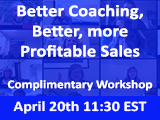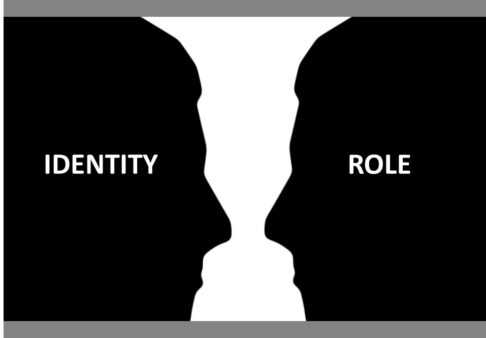Last month HVACR Trends sponsored a sales coaching training workshop focused on driving sales performance through coaching. We shared “why” this is a critical skill that essentially every distributor and manufacturer rep needs to invest resources (at least thought process and time) into. Manufacturers may need similar, especially if they have a direct salesforce or sales engineers / business development staff, however, given the evolving role of regional managers, the “coaching” process may need to be refined.
One of the topics that Greg Nanigian, from GNA Training, focused on last month was IR Theory, which can be a powerful coaching technique.
The group was segmented into breakout groups and the intimate environment added to the interaction.
Due to the session’s success, and that we had some who inquired about the session afterwards, I asked Greg to share more about IR Theory and to host another session to benefit the industry.
 It’s a free event scheduled for Thursday, April 20th at 11:30 AM EDT. Click here to register.
It’s a free event scheduled for Thursday, April 20th at 11:30 AM EDT. Click here to register.
Identity Role Theory and Resilient, Successful Salespeople Leads to Sales
There is one thing I have found to be pivotable in terms of increasing the performance of sales team members, and that one thing is their sense of identity.
One of the keys to improving performance is to help the salesperson improve their sense of identity, sometimes referred to as self-esteem, self-image, or self-worth.
To determine what your salespeople’s sense of identity is, do this exercise.
- Start by asking them to put a little circle on a piece of paper.
- Tell them to visualize themselves on a deserted island. They are only going to be there for 10 minutes, so they do not have to worry about survival. While they are there, they will not have any of their roles. They will not be the salesperson, they will not be a mom, they will not be a tennis player, they will not be a golfer, they won’t be a dad, they won’t be a sister or brother. So, it is “you” without any roles whatsoever.
- Ask them to then rate their self-worth on a zero to ten scale. Ten would be the highest and zero would be the lowest. Have them put the number in the circle but you do not want them to share the number out loud and you’re not going to ask them to share it with you. In this way, you’ll create a safe environment for them to fill in an accurate number in the circle.
Generally, you are going to get numbers in the four to seven range. People that rate themselves in this range are what is called “Psychological At-leasters”. We want to maximize performance, and to raise their self-esteem to 10.
There is a rule I want to give you right up front – People can only perform in a manner that is consistent with how they see themselves conceptually. So, if you take Wally Weakcloser, who scored himself a five in the island exercise, he will perform in a four to six range in his selling role. If he rises above six in terms of his performance, he is prone to take a day off or not work as hard or as smart. In this way, he will “correct” into his comfort zone. A person’s comfort zone is a range from + 1 point to -1 point of how they see themselves conceptually. Another example is “Wendy Winner”. In the island exercise, Wendy scores herself a nine. She is consistently a top performer and performs in the eight to ten range in her role as salesperson.
Born as a 10
The thing you need to know is that we are all born into the world as 10’s. During our upbringing, we each were treated in diverse ways. If we performed well in a given area, we got treated in a certain way. If we did not perform so well, we got treated in a different way, generally speaking.
Typically, when we reach adulthood, we end up in one of three psychological groups – Non-winners, At-leasters, and Winners.
- Non-winners are people that would score themselves 0, 1, 2, 3 in the island exercise.
- At-leasters would score themselves 4, 5 or 6.
- Winners score themselves 7, 8, 9, 10.
Winners make a separation between role performance and identity. No matter what happens in their role, they will not take it personally. Or if they do, it is for a very brief amount of time, and they bounce back very quickly. They are resilient. They understand there is a difference between their role performance and their self-worth. In other words, there is a difference between who you are as an “I” and who you are as a “R”.
“I” means Identity and “R” means Role.
The At-leaster, if they have a good day at work, when they get home at night, they feel good about themselves. If they have a crummy day at work, when they get home, they beat themselves up. They take what happens on the role side personally. They do not see a separation between their identity and their role performance. Like the old adage, “you are what you do”. Whereas the winner sees the separation between Identity and Role. There is a huge difference in the way that they perceive things, and it has a large effect on their role performance. Non-winners usually do not end up in sales. But if they do, the level of adversity that salespeople deal with on an ongoing basis deters them from lasting very long or they are habitual underachievers.
Improving Self-Worth / Self-Image
The question then becomes: How do you improve the self-worth/self-image and Identity of sales team members?
Some approaches are:
- Complimenting them on their role performance or “R” Strokes. Psychologists call these compliments “strokes”.
For example, consider the effect when you stroke a baby on their forehead. The baby perks up. In adulthood, strokes for role performance typically reinforce positive behaviors. On the other hand, you must be sure that those strokes are earned. If you are giving strokes to somebody for doing an excellent job at prospecting when they are hardly making any prospecting calls, they will lose respect for you. In fact, the entire team will lose respect for you if you give out unearned R (strokes). All this does is reinforce negative behavior. There are other ways you can improve a person’s self-worth.
- Another approach is called “I Strokes” or Identity strokes. For example, “Hey Joe, I really like working with you”. Identity strokes are just for who the person is. They are not for role performance.
- Another way to build self-esteem is to put your people in a good goal-setting program.
There are many good sales training programs that incorporate good goal-setting programs.
- Another approach is therapy. If a person cannot drop their baggage, they may need help.
- Another way is a catastrophic event. There is an old, and dated, one liner, “he went away to war and came back a changed man”. Although dated, because of course women have been going away to war for many years, it still makes the point. A catastrophic event can be a script changer and changes the individual’s self-esteem.
For sales managers, the most practical, and effective, ways are good goal-setting programs and using strokes. Take the time on a weekly basis to give “I” and “R” strokes to your team. All of these must be combined with good supervision, mentoring, coaching, and training.
 I hope you got something out of this article. I will go in more depth at our upcoming workshop for HVACRTrends readers on Thursday, April 20th at 11:30 AM . Click here to register.
I hope you got something out of this article. I will go in more depth at our upcoming workshop for HVACRTrends readers on Thursday, April 20th at 11:30 AM . Click here to register.
